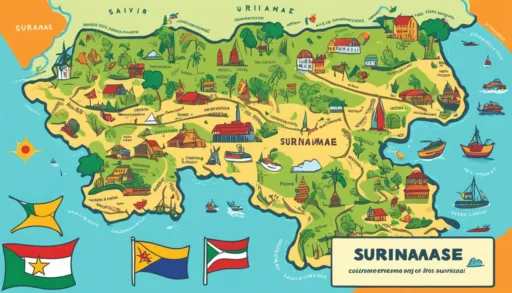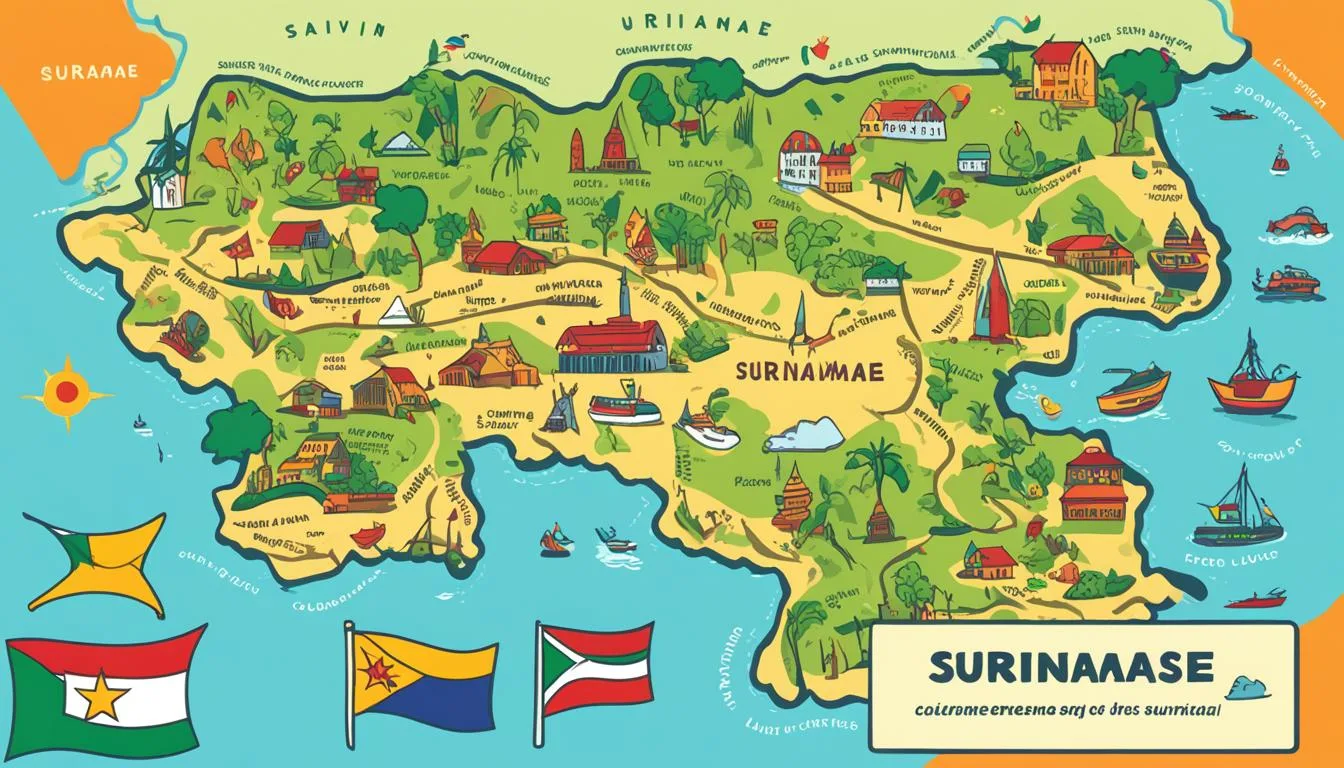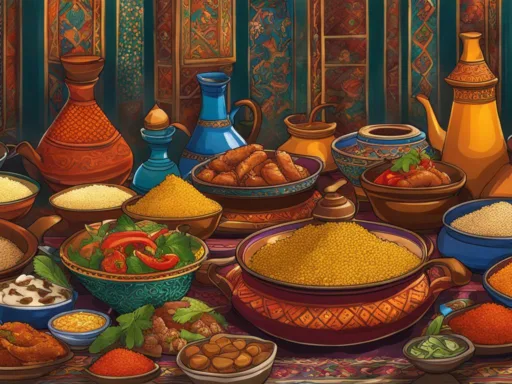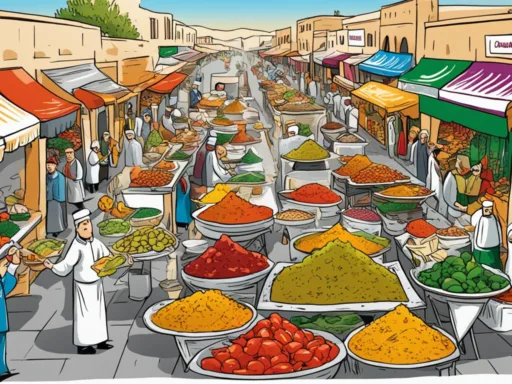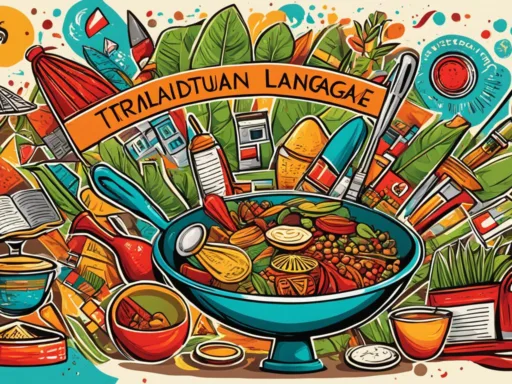Imagine a country where nearly every conversation is a thread in a vibrant tapestry of languages; this is the reality in Suriname. With a modest population just above half a million, Suriname boasts an astounding number of languages spoken across its territory. In this northern South American nation, one can encounter an average of four different languages in a single day—making it a linguistic phenomenon. Suriname’s linguistic diversity is not just impressive; it is a reflection of a rich cultural mosaic that has been centuries in the making.
This intricate patchwork comprises not only the official language, Dutch, but also a symphony of speech that tells the story of Suriname’s history and its people. From indigenous tongues whispered in the shadows of the Amazon rainforest to the melodic intonations of Asian languages brought over by 19th-century indentured laborers, each linguistic thread adds a unique hue to the country’s identity. Here, in Suriname, language is more than a tool for communication—it is the very fabric of society.
Key Takeaways
- Dutch serves as Suriname’s official language, reflecting its colonial past and current administrative framework.
- The linguistic diversity of Suriname spans indigenous, creole, and immigrant languages, highlighting a complex socio-cultural landscape.
- Suriname’s capital, Paramaribo, is a hub where a cross-section of the nation’s languages is most audible.
- The array of languages spoken in Suriname underscores its stature as a unique enclave of linguistic variety in the region.
- Understanding Suriname’s language use is key to appreciating the depth of its multicultural heritage.
The Multicultural and Multilingual Society of Suriname
Embark on a journey exploring the vibrant tapestry of Suriname’s society, a testament to its stirring history and the multitude of tongues that echo throughout its landscape. Dutch, as the official language of Suriname, is just the starting point in understanding how this nation’s dialects came to be as diverse as its people.
Colonial History and Its Impact on Language
The seeds of Suriname language diversity were planted during the colonial era. The Dutch, asserting dominance in the 17th century, imprinted their tongue onto the local fabric, intertwining it with indigenous languages and those of the African and Asian laborers. This complex past paved the way for a society where a medley of languages represents the struggles and resilience of its people.
Modern Suriname’s Linguistic Demographics
Today, the demographic mosaic of Suriname reflects no singular ethnicity above another—each with a voice in their native tongue or the remnants of their ancestors’. Language remains a living piece of the nation’s jigsaw, making Suriname’s language culture as colorful as its festivals.
The Role of Language in Surinamese Identity
In dialogue with the times, languages in Suriname are not merely echoes of a colonial era but represent the dynamic veins of identity flowing through every Surinamese. Emerging from a history steeped in exchange and adaptation, the country’s linguistic map continues to be charted, negotiating its relationship with tradition and modernity.
Dutch: The Official Language of Suriname
Dutch Suriname harbours a linguistic legacy that permeates the facets of its society—most prominently, in the realm of education in Suriname. Known for its verdant rainforests encompassing much of the land, Suriname’s urban heartbeat follows the rhythm of its Suriname official language, Dutch. Holding the distinction of being the only Dutch-speaking nation in South America, Suriname solidifies the significance of Surinamese Dutch not merely as a language, but as the cornerstone of national identity and communication.
In Paramaribo, the cosmopolitan capital, Dutch resounds through classrooms and corridors of power alike, illustrating its ubiquitous presence in urbanized areas. Furthermore, the Surinamese variant of the language was crystallized by the publication of the “Woordenboek Surinaams Nederlands”, which serves as an affirmation of its linguistic nuances unique to Suriname.
| Aspect | Influence of Dutch |
|---|---|
| Education | Medium of instruction from primary to tertiary level |
| Media | Main language for broadcasting and journalism |
| Government | Official paperwork and parliamentary proceedings |
| Culture | Literature and daily communication among diverse ethnic groups |
| Business | Corporate transactions and international trade |
While a fusion of other languages pepper the cultural landscape, Dutch remains the unifying thread, especially significant in educational policy. With a majority of around 60% of Surinamese speaking Dutch natively and others acquiring it as a second language, its pivotal role in daily life remains unchallenged, even as Suriname continues to nurture its diverse linguistic roots.
Languages Spoken in Suriname
The Suriname linguistic landscape is as varied as it is vibrant, painting a picture of a truly multicultural society. With an array of languages that echoes the country’s complex history and ethnic diversity, understanding the languages spoken in Suriname provides a glimpse into its cultural fabric. From the prevalent Dutch to the Creole languages that mirror centuries of history, Suriname’s language diversity is truly a phenomenon to delve into.
Foremost among the tongues spoken is Sranan Tongo, a Creole language that serves as the lingua franca for many Surinamese. Bridging cultural gaps, it stands alongside Surinamese Hindi, which holds its own as a prominent voice within the Indo-Surinamese community. The Maroon languages like Saramaccan and Ndyuka, too, narrate tales of endurance and identity, while Amerindian languages such as Akurio and Carib are testament to the land’s original spirit.
The influence of the past, with its indentured servants from Asia, is evident in the usage of Javanese and Chinese, reflecting an intricate past that has now settled into the hum of daily life. The Suriname language diversity is further augmented by global languages like English, Spanish, and Portuguese. What emerges is a rich tapestry—a world contained within a country, a conversation between continents.
Below is an overview of the linguistic diversity that adds color to the Surinamese culture:
| Language | Origin/Influence | Function in Society |
|---|---|---|
| Dutch | Colonial Influence | Official Language, Used In Government and Education |
| Sranan Tongo | Creole | Lingua Franca, Cultural Identity |
| Surinamese Hindi | Indo-Surinamese | Cultural Expression, Daily Communication |
| Saramaccan/Ndyuka | Maroon Languages | Maintaining Maroon Heritage |
| Akurio/Carib | Amerindian Languages | Cultural Identity of Indigenous Tribes |
| Javanese | Indentured Servants from Java | Preservation of Javanese Surinamese Culture |
| Chinese | Chinese Immigrants | Cultural Preservation, Business Dealings |
| English/Spanish/Portuguese | Global Languages | Education, International Business, Communication with Migrants |
In examining the languages spoken in Suriname, it becomes clear that this country’s linguistic melange is not just about communication—it’s about community, history, and the ever-unfolding story of Suriname’s people.
The Influence of Sranan Tongo on Surinamese Culture
The unmistakable cadence of Sranan Tongo resonates through the streets of Suriname, serving as a testament to the country’s colonial past and its modern vibrancy. This English-based creole language holds a cherished position in the Surinamese language culture, transcending its utilitarian roots to become a core element of national identity.
The Origins of Sranan Tongo
Forged in the crucible of Suriname’s colonial era, the genesis of Sranan Tongo can be traced to a mixture of Dutch, Portuguese, English, and various African languages. Developed as a lingua franca among slaves, it embodies the resourcefulness and resilience of a people caught between worlds, turning a tool of survival into a profound cultural cornerstone.
Sranan Tongo’s Place in Contemporary Suriname
In present-day Suriname, Sranan Tongo weaves itself into daily dialogue as a reflection of the nation’s heart and spirit. While it is not part of the formal educational curriculum, its pulsating rhythms and melodies fill the air and art, captivating the minds and souls of the locals, notably the younger generations and the Creole population.
Its prevalent use in casual conversation and media illustrates the significant role Sranan Tongo plays in the knitwork of languages spoken in Suriname. This creole language is not merely a means of communication but an expression of the past and a declaration of Surinamese identity.
Indigenous Languages Preserving Suriname’s Heritage
The fabric of Suriname is richly interwoven with the threads of indigenous languages, each echoing the collective memory and identity of its Amerindian peoples. Languages such as Warao and Wayana, spoken by the Arawaks and Caribs, are emblematic of the nation’s historical depth and cultural plurality. Their continuation is a testament to the resilience of these communities.
Amerindian Languages of Suriname
Within Suriname, a myriad of Amerindian languages persists against the relentless tide of globalization. From the oral traditions carried by the Warao language to the Wayana tongue narrating ancestral tales, these idioms are an cultural preservation endeavor that echo through the dense forests of the nation’s interior.
The Efforts to Revitalize Indigenous Languages
Recognizing the crucial role that indigenous languages Suriname play in maintaining a vibrant cultural landscape, concerted efforts are underway to ensure they not only survive but thrive. These endeavors encompass a range of strategies such as:
- Documentation of languages to create a written record and educational resources.
- Language courses and workshops aimed at boosting fluency among younger generations.
- Integration of indigenous idioms into multimedia platforms and school curricula.
- Community-driven programs fostering daily use of indigenous dialects.
Each of these efforts contribute to an overarching campaign to uphold and celebrate an essential facet of Suriname’s identity—the diverse and distinctive voices of its first inhabitants.
Legacy of Indian Languages in Suriname
Suriname’s remarkable tapestry of languages includes the significant contribution of the Indo-Surinamese population, a community grounded in the history of 19th-century migrant laborers from British India. They introduced Sarnami Hindustani, a vibrant dialect of Bhojpuri, carving a unique linguistic space in Suriname’s diverse cultural landscape. Notably, Sarnami Hindustani ranks as the third most spoken language in the country. Its usage, varying across regions and often interwoven with Dutch expressions, symbolizes a living bridge to ancestral stories and traditions.

As we delve into the influence of Indian languages on Suriname’s linguistic diversity, we find Sarnami Hindustani deeply interlaced with the daily lives of Indo-Surinamese communities. Here’s a concise look at how this language emphasizes the intricate relationship between Suriname’s language diversity and its cultural dynamics:
- Manifestation of historical ties with India.
- Preservation of cultural heritage within a creole-dominated society.
- Emotional and ancestral identity element for the Indo-Surinamese diaspora.
The status of Sarnami Hindustani amidst the official languages of Suriname showcases the continual evolution of the country’s linguistic identity and the critical need for fostering appreciation towards this heritage for future generations.
| Districts with High Sarnami Hindustani Usage | Interactions with Other Languages |
|---|---|
| Nickerie | Dutch and Sarnami Hindustani in Education |
| Wanica | Sarnami Hindustani in Commerce and Family Settings |
| Saramacca | Mix of Sarnami Hindustani and Sranan Tongo in Community Dialog |
Incorporating Sarnami Hindustani into the national discourse further enriches Suriname’s language diversity, echoing the enduring spirit of a nation shaped by the confluence of its ancestral voices.
Tracing the Javanese Language in Suriname
The journey of the Javanese language across oceans is a remarkable tale of resilience and cultural identity. As we delve into the linguistic nuances of Suriname, the Javanese language stands out as a testament to the nation’s considerable linguistic diversity. Immigrants from the Dutch East Indies brought more than just their labor to the plantations; they carried their mother tongue to the heart of the Caribbean, contributing profoundly to the fabric of Suriname society.
Javanese Migration and Its Linguistic Contributions
The influence of Javanese settlers in Suriname began in the late 19th century when the Dutch colonizers recruited contract workers from present-day Indonesia. These Javanese migrants irreversibly interwove their language, customs, and traditions into the country’s ethos, adding another layer to the rich tapestry of Suriname’s linguistic diversity.
Current Status of the Javanese Language in Surinamese Society
Despite Javanese not being one of the official languages of Suriname, it commands a unique role in the multicultural landscape. Its prevalence today may be more modest, yet it continues to resonate within the Javanese communities in Suriname. Through generations, the Javanese people have maintained their linguistic heritage, ensuring that their voice is indelibly part of Suriname’s cultural chorus.
In essence, the Javanese language’s enduring presence in Suriname is more than just a consequence of historical migration. It is a living bridge between the nation’s past and its present, contributing vibrantly to Suriname’s ongoing narrative of linguistic diversity.
The Presence of Maroon Languages in Suriname
The rich tapestry of languages spoken in Suriname is significantly attributed to the Maroon communities whose origins are deeply rooted in the country’s heritage. Descendants of African slaves who fled from plantations, the Maroons carved out independent settlements in the dense jungles of Suriname, preserving and nurturing their unique cultural identities through language.

The Maroon Community and Their Languages
The survival and continuity of the Maroon languages, including Saramaccan, Aukan, and Aluku, reveal a story of resilience and adaptability. These languages encapsulate the spirit of the communities that speak them, offering insights into a past marred by strife but overcome with strength and unity.
Maroon Languages: A Bridge Between Past and Present
Standing as a testament to the enduring spirit of its speakers, Maroon languages serve as a critical bridge connecting the Maroon’s storied past with their evolving present. Through the whispers of their ancestors and the expressive semantics that underpin their daily interactions, Suriname’s Maroons continue to shape a linguistic heritage that is as dynamic as it is historic.
| Language | Community | Status |
|---|---|---|
| Saramaccan | Saramacca | Vibrant and evolving |
| Aukan (Ndyuka) | East Maroon | Widely spoken, socially integral |
| Aluku | Boni | Culturally preserved |
Creole Languages: A Testament to Suriname’s Diversity
The rich tapestry of Suriname’s cultural heritage is vividly woven through its Creole languages. Originating from a period of tumult and transformation, these languages encapsulate the complex interplay of history and culture within the nation. Sranan Tongo, which stands out among the Creole languages in Suriname, carries a tale of creation—a Creole genesis that marked a new cultural identity born from the interactions of European and African ancestries.
Development of Creole Languages in Suriname
The emergence of Creole languages in Suriname, such as Sranan Tongo, is a poignant chapter in the nation’s history. These languages arose from the creolization process during the transatlantic slave trade era, forging a linguistic bridge between European languages and various West African tongues. Through the intermingling of different lexicons and grammatical structures, a new means of communication was crafted, not merely for practicality but as a representation of a new social fabric.
The Everyday Use of Creole Languages and Sranan Tongo
Today, the everyday reality of Suriname’s language diversity is intertwined with the spontaneous use of Creole languages, especially within casual conversations on the bustling streets of Paramaribo. Sranan Tongo, with its resonant voice, is heard in markets, schools, and neighborhoods, and echoes throughout the diverse strata of Surinamese society. It lives not only in speech but pulses through the nation’s vibrant popular culture, influencing music, literature, and the arts—cementing its role as a cornerstone of Surinamese identity.
These languages, birthed from a fusion of global narratives, remain a powerful testament to Suriname’s diverse linguistic landscape. Alongside Dutch, the Creole languages of Suriname, especially Sranan Tongo, continue to showcase the nation’s adaptability and social cohesion. They are more than mere methods of communication; they are living embodiments of the nation’s ongoing dialogue with its complex past and its dynamic present.
Suriname’s Linguistic Landscape and Global Languages
Suriname’s rich tapestry of indigenous and creole tongues is further adorned by the intricate threads of Suriname’s global languages. The languages not only showcase Suriname’s linguistic diversity but also highlight the country as a vibrant hub of multicultural exchanges. Global tongues such as English, Spanish, and Portuguese are not merely peripheral elements of Suriname’s verbal repertoire; they are essential components that reflect the dynamic international connections and migratory patterns shaping this South American nation.

English, with its pervasive role in education and international trade, stands out as a significant tool in Surinamese society. Alongside Dutch, the nation’s official language, English acts as a conduit for global media content, serving as a bridge to greater engagement with the worldwide community. This has effectively positioned English as a language of youth aspiration and upward mobility. Spanish and Portuguese mark the linguistic crossroads where Suriname intersects with its Latin American neighbors, facilitated through a growing number of expatriates and migrants who have made Suriname their home.
| Language | Role in Suriname | Origin of Influence |
|---|---|---|
| English | Educational system; Business and trade interactions | Global media; International Business |
| Spanish | Spoken by migrants and expatriates; Cultural exchange | Neighboring Latin American countries |
| Portuguese | Community interactions; Expanding business opportunities | Brazilian migrants; Trade partnerships |
Given that Suriname forms part of the Caribbean Community (CARICOM) and the Union of South American Nations (UNASUR), the adroitness in global languages further enforces its strategic position within these regional bodies and fosters stronger diplomatic and economic ties. This versatility in communication underlines the cultural adaptability of Surinamese society, cementing its place as a crossroads of civilizational narratives and a melting pot where Suriname’s linguistic diversity is celebrated.
Educational Policies and Language Teaching in Suriname
The tapestry of education in Suriname is a reflection of the country’s rich linguistic fabric, where languages spoken in Suriname shape the learning experience. Dutch remains the primary medium of instruction across schools, yet there’s a noticeable shift towards bilingual education, acknowledging the necessity for a culturally inclusive educational model. This push encourages students to connect with their heritage while developing proficiency in the official language.
Language teaching strategies within Surinamese education systems are emerging to provide a more equitable platform for all languages in the nation. Educational reformists are promoting multilingual curricula that honor the linguistic diversity of students, offering them a more relatable and comprehensive learning environment.
| Feature | Purpose | Impact on Students |
|---|---|---|
| Dutch as the first language of instruction | To maintain official language decorum in academics | Enables full participation in local governance and international communications |
| Inclusion of native languages | To promote cultural identity and inclusivity within the educational system | Respects and preserves students’ linguistic heritage |
| Bilingual Education Programs | To facilitate a dual-language learning environment from an early age | Enhances cognitive flexibility and appreciation for diverse language use |
Bilingual education initiatives not only strengthen national identity but also empower learners to excel in a globalized context. Navigating through a curriculum that respects both the sovereign language and the indigenous linguistics embodies the progressive spirit of Suriname’s educational policies.
The conversation around education in Suriname continues to evolve, with stakeholders considering the pedagogical benefits of integrating the vast array of languages spoken in Suriname into academic programs. The future for Suriname’s scholars seems to be intimately linked with a profound respect for linguistic diversity, charting a course where multiple tongues become instruments for unity rather than division.
Conclusion
The tapestry of languages that forms Suriname’s societal fabric is not merely a relic of history but a vibrant part of its current reality and a cornerstone for future development. The recognition and valorization of linguistic diversity in Suriname fortify the nation’s cultural identity and reinforce unity amidst diversity. With Dutch serving as the official language, Suriname navigates the path of preserving its linguistic heritage while addressing the complexities of a multilingual society. The ongoing discourse on Suriname’s language policy mirrors the broader determination to celebrate its rich linguistic mosaic.
Embracing Linguistic Diversity as Suriname’s Strength
Linguistic diversity in Suriname offers a unique advantage that sets the country apart on the global stage. By integrating the full spectrum of languages within educational frameworks and national dialogue, Suriname showcases a commitment to inclusivity that contributes to social harmony. This approach also supports the resilience of minority languages, ensuring they continue to thrive. The dynamic interplay of languages is a form of cultural wealth that Surinamese people proudly demonstrate in their daily interactions.
Future Perspectives on Language Use in Suriname
The future of languages in Suriname posits a society in which multilingual proficiency is increasingly viewed as an asset—a society ready to engage with global trends while sustaining its unique linguistic character. As the world becomes more interconnected, Suriname’s language policy may further evolve, potentially expanding opportunities for languages beyond Dutch to gain prominence in various sectors. This forward-looking perspective encourages a dialogue that might lead to innovative approaches to language education and use, ensuring that Suriname’s linguistic diversity is not only preserved but propelled into a new era of appreciation and application.
